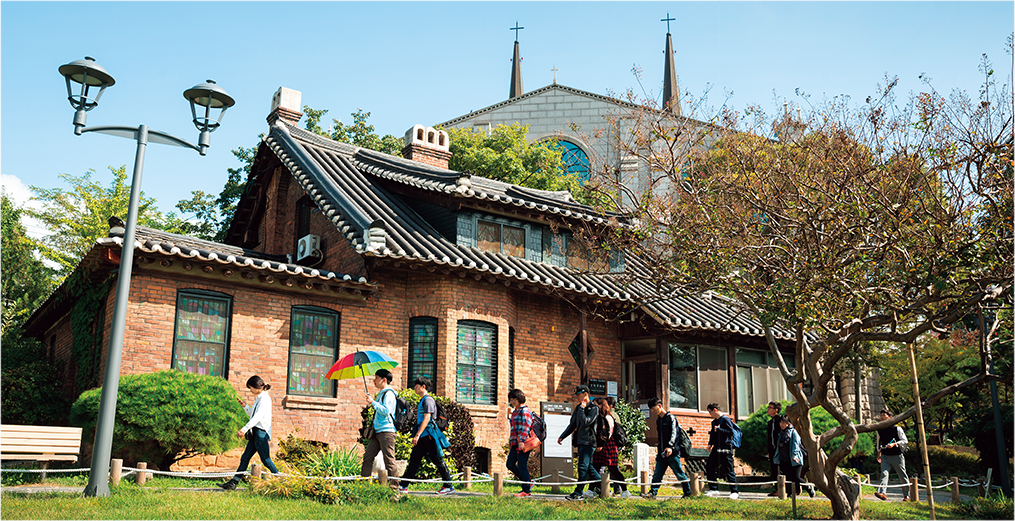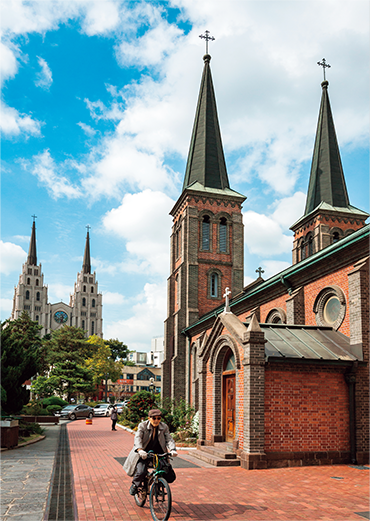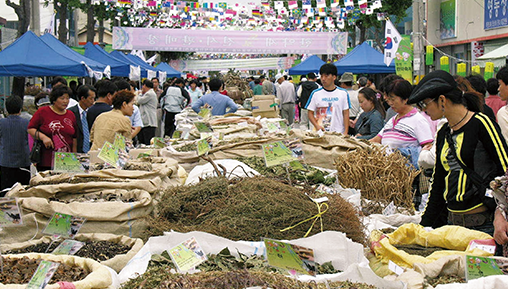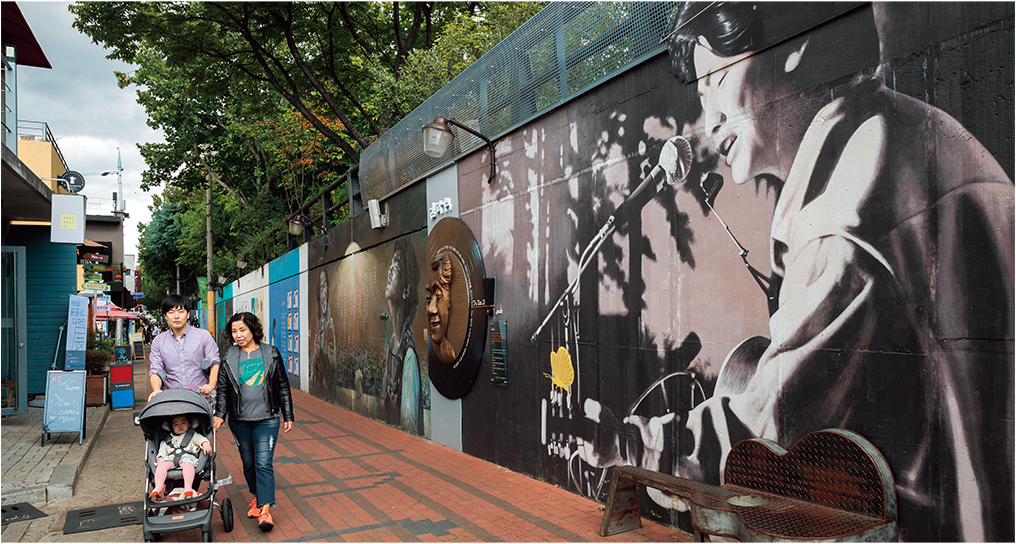The name Daegu means “big hill,” and true to its name the city is made up of
countless interwoven alleyways on top of a hill. Each alley has its own history and
stories to tell. Cheongna Hill, which brings to mind Montmartre in Paris, and the
Western-style Gyesan Cathedral sitting on top form a sort of outdoor museum
offering an enchanting glimpse of Korea’s early modern period.
Daegu once had so many apple orchards
that every hill seemed to be covered in
white apple blossoms in spring, and the
Daegu apple was known to be the tastiest
in the country. Under the influence of
climate change, however, the apple
cultivating zone has moved northward
and apple orchards have virtually
disappeared from Daegu’s landscape.
I was around 17 years old at the time. I was on a school field trip. In those days, it was an exciting thing for students to set out on a trip to explore historic sites around the country before they finished high school. The final destination on our trip was Gyeongju, the ancient capital of the Silla Kingdom.
Before the bus rolled into the city, we saw a hill covered with an endless number of apple trees. It was spring and the apple blossoms were in full bloom. When I opened the window, the wind came blasting through and white petals flew about everywhere. That’s when I learned that the term “shower of petals” was not a fantasy. After the bus drove through the falling petals for a good while we finally reached Gyeongju, but to this day, rather than the ancient city’s numerous historic remains it is the sight of white apple blossoms flying in the wind over the hillside town that remains in my memory. The name of that hillside town was Daegu.
Though much time has now passed, I still associate Daegu with the scent of apple blossoms. The hills were covered with white apple blossoms and houses were nestled between the trees, and this sight must have aroused my poetic sentiment. Forty-five years have passed since then and Daegu has undergone great changes. It has become a big city of 2.5 million people, and under the influence of climate change, most of the apple orchards have disappeared.
“Travel to the Modern Times: A Thousand Alleys and a Thousand Stories”
When I reached downtown Daegu, the above slogan came into sight. A sign bearing this slogan stood at the entrance to every alley like a milestone. Each sign mentioned different names, however, such as “sock alley,” “printing alley,” “intestines alley” and “beef rib alley.” There’s something heartwarming about the way the thousand alleys and the stories of everyday life filling them have been taken as a theme to promote tourism in the city.

The garden of the Switzer House, built around 1910, has a descendant of the first apple tree ever brought to Korea from the United States. American missionary Martha Switzer once lived at the house. She is buried in the Garden of Mercy nearby.
Streets Imprinted with Scenes of Modern History
Old-time Daegu locals love to climb a small hill called Cheongna. The name means the “blue-tinted Boston ivy,” and this is where many of Korea’s early modern buildings can be found, including a church, school and hospital. Alien and unfamiliar at the time, these buildings with their red brick and green ivy-covered exteriors attracted their fair share of attention. The Daegu locals call the hill “Montmartre,” and love it for that reason.
Park Tae-jun (1903–1986), a Daegu-born composer, wrote a lyric song entitled “In Memory of a Friend” (“Dongmu saenggak”). There is a story behind the song. Park was in love with a girl who was attending Sinmyeong School. He told Lee Eun-sang (1903–1982), a sijo poet, about it and Lee wrote the lyrics of the song in 1922. “My heart is like Cheongna Hill / My lily-like friend / When you bloom from my heart / All sadness disappears.” These lines left their mark deep in the hearts of countless Koreans suffering in the throes of first love. It was a song loved by the whole country.
On top of Cheongna Hill sit three houses that were once the residences of foreign missionaries who came to Korea in the late 19th century. One of these is Switzer House, and in the garden stands a descendant of the first apple tree ever brought to Korea from the United States. Woodbridge O. Johnson, the first director of the Dongsan Hospital, brought an apple tree with him when he came from Missouri in 1899 and planted it in the garden. Although the original tree no longer exists, its progeny gave birth to the Daegu apple and is hence an apple tree with a deep and rich history. The red apples, the size of plums, were lovely to see.
A small stairway called “The Road of 90 Steps” or “March 1 Independence Movement Road” links Cheongna Hill with the downtown area. On March 1, 1919, Koreans all over the nation rose up against the Japanese colonizers in a movement for independence. At the time, Daegu students used this lane running through the forest to enter the city and shout for independence. To avoid the Japanese police, it is said that male students dressed as merchants and female students carried basins as if they were going to the stream to do the washing.

Gyesan Cathedral, built in the Gothic style in 1902, is Daegu’s first Western style building and an outstanding example of Korea’s early Christian architecture.
Not a Long Alley, Despite the Name
The steps lead down to a big street and Gyesan Cathedral. Built in 1902 in the Gothic style, the cathedral was the first Western-style building to go up in Daegu and is one of the oldest cathedrals in Korea. A mass was under way when we got there. The voice of the priest and the sunlight shining through the stained glass windows was warm and pleasant. On May 5, 1984, Pope John Paul II held mass here to canonize 103 Catholic mar Varanatyrs.
Nobody would have guessed that, 82 years after the cathedral was first built, the pope himself would lead a mass here.
Down the alley next to Gyesan Cathedral is the old home of the “people’s poet” Yi Sang-hwa (1901–1943).
Will spring come to these stolen fields —
now another’s land?
Bathed in sunlight I walk as if in a dream along the lane
Cutting through the rice paddies like the part in one’s hair
Toward where the blue sky and the green fields meet.
Thus begins Yi Sang-hwa’s poem, “Will Spring Come to These Stolen Fields?” that stirred the hearts of the Korean people, who were dreaming of freedom and independence. Imperial Japan closed down the literary magazine Gaebyeok (Great Beginning), which had published the poem, an indication of the fear they felt at this piece of literature.
The alley leads to Jin Alley, or Jingolmok in Korean, which is Daegu dialect for Gingolmok, meaning “long alley.” When Daegu locals say, “I’ll meet you there,” everybody knows “there” means this alley. But contrary to the name, the long alley is not so long. It differs greatly from the alleys of Varana si in India, where it is so easy to get lost, or the Medina of Fez in Morocco, a UNESCO World Heritage site. It probably has something to do with the status of those who made these alleys their home. Homes of the ordinary people densely line the alleyways in Varanasi, but Jingolmok was home for Confucian scholars who constituted the upper class of Daegu.
I remember the first time I set foot into Varanasi. With the big idea of drawing a “maze map,” I entered the alley leading to the crematorium. The monsoon rains had made a mess of the narrow passage, less than a meter wide and filled with a foul stench. Every five minutes a procession of people carrying a dead body to the crematorium entered the alley. The sound of their prayers to Shiva was gloomy. And for some reason, there were so many cows. When a cow made its way into the alley, there was nothing left to do but stand back close to the walls, brushing with the cow as it passed. That was the day I gave up my dream of drawing a maze map. My modest travel experience, I realized, was no match for the rough and unforgiving city of Varanasi.
In recent times,
this traditional alley
filled with medicine
merchants has become
increasingly popular
with young people and
travelers, thanks to
the presence of coffee
shops with sleek interiors.
It has become an alley
like no other in the world,
where the smell of herbal
medicine blends with the
aroma of coffee. There is
no place like it —
not even in Varanasi or
the Medina of Fez.

The herbal medicine market in Daegu, with a history dating back to 1658, is the biggest market of its kind in the southern part of Korea. In its heyday, the market drew merchants not only from China and Japan but also from Arabia.
Happiness in the Old Markets
From Jingolmok I went on to the old herbal medicine market called Yangnyeongsi, just 10 minutes away on foot. Daegu natives like to call it the “medicine alley.” From the entrance, the smell of herbal medicine brews assails the nose. The pride of the locals is evident when they joke, “Just walking through the alley will cure you.”
The scent is the essence of herbal medicine; the scent unique to each ingredient chases away the diseased energy inside the body. In that respect, those living near the market are happy people. At the onset of a cold or a hint of indigestion, a stroll through this market for an hour or two will alleviate the symptoms. How could they not be happy? The market rose out of the tradition of selling medicines here every spring and autumn, which began in 1658. In its heyday, it was apparently a famous international market, attracting merchants not only from China and Japan but from as far away as Arabia.
In recent times, this traditional alley filled with medicine merchants has become increasingly popular with young people and travelers, thanks to the presence of coffee shops with sleek interiors. It has become an alley like no other in the world, where the smell of herbal medicine blends with the aroma of coffee. There is no place like it — not even in Varanasi or the Medina of Fez. For any traveler with a special sensitivity to smell, Daegu’s medicine market must not be missed.
Next, I plodded over to Seomun Market. As soon as I got there, I knew without a doubt that I was at the biggest market in the southern part of Korea, with endless rows of stores selling fruit and vegetables, clothing, fish, meat, and dried foods. I bought a dried squid and chewed it as I strolled through the market. But no matter how much I walked, there seemed to be no end.
The happiness of visiting a traditional market comes from buying the goods you want after haggling a bit with the seller. I remembered something that had happened to me at the Grand Bazaar in Istanbul. This market, established in the 15th century, has some 5,000 stalls and everything that is sold has a traditional feel to it. The household items, furniture, clothes, silks, silver crafts and carpets all featured medieval designs and patterns.
At the market, I bought myself a handmade carpet. Loath to carry it around, I had told the merchant I would only buy it if he could guarantee that the carpet would be safely sent to Korea. Upon hearing this, he opened up an old safe and took out a bunch of old contracts. I was astonished to see that they were from the 15th and 16th centuries, and that on each there was a skull motif with the chilling phrase, “Honor the contract or die.” I had faith in these contracts as soon as I saw them. Sure enough, two weeks after I had returned to Korea, a package containing the carpet arrived at my house.
In Memory of a Singer Who Died Young
Bangcheon Market was formed during the Korean War by North Korean refugees and displaced South Koreans who were unable to return home. People say that the market, at its peak, consisted of more than 1,000 stalls and all merchants who gathered there had their own incredible life stories to tell. Going through a series of ups and downs, the market eventually became a fairly mundane place for poor, plain people.
But in recent times, people wanting to save the market from obscurity created a space in memory of the late singer Kim Kwang-seok. In an alley just wide enough for three or four people to stand shoulder to shoulder, murals paying tribute to Kim’s life and his songs have been painted, inscribed with memorable quotes and song lyrics.
There is an outdoor stage where Kim’s songs are performed and the sounds of buskers fill the alley.
Kim Kwang-seok is one of Korea’s most beloved pop singers. His songs soothed the souls of Koreans as they suffered under military dictatorship and authoritarian rule, helping them to live through those difficult times. Young men reaching the age of 20 would sing “The Soldier’s Letter” as they went to serve their military duty, and “Around the Age of Thirty” is the favorite with everyone in their thirties. “The Story of an Old Couple” is infused with the plaintiveness of an old couple who have lived a hard life.
The plan to memorialize Kim Kwang-seok, whose life and music was a product of the alleys of Bangcheon Market where his father ran a store, was a success, for the market now attracts an endless stream of visitors who come from all over the country to remember the singer. It would not be too much to say that the market is sacred ground for hardcore Kim Kwang-seok fans. It is not only Koreans who sympathize with the life and music of the singer, who died at the age of 32. Tourists from Southeast Asia, China and Japan are also a common sight there.
When night had fallen, I set out for the gopchang (beef or pork intestines) alley in Anjirang. I was caught by the name “Youth Alley” marked on my guide map of the city. Who doesn’t look back on their younger years with fondness?
Those who are young at this moment gather in the alley, hand in hand, and those long past their youth come here with a longing for the good old days.
When I reached the alley, I was amazed to see so many restaurants selling beef or pork intestines. This market alley may well be the largest in the world specializing in gopchang dishes. But I couldn’t bring myself to enter a boisterous restaurant alone to sit down and eat. I couldn’t help thinking that “Come with your friends to drink, talk, and be in love” was this market’s outlook on the world.
On my map I found the “Dokkaebi Night Market Alley” in Gyo-dong. Okay, that’s my next stop, I said to myself. If I go there, perhaps I’ll find some lonely dokkaebi (mythical being similar to a hobgoblin) to have dinner with. Indeed, just the thought of meeting and making friends with some of the dokkaebi I had seen in childhood story books made me feel happy. I hurried toward the alley.

A memorial to Kim Kwang-seok is a popular spot in Bangcheon Market, where he spent his childhood. Murals paying tribute to the life and songs of the singer, who died in 1996 at the age of 32, line a narrow alley attracting an endless stream of visitors.